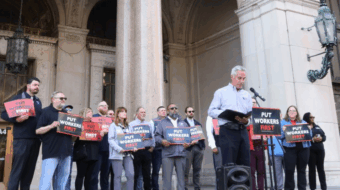DETROIT, Mich. – With its gleaming stainless steel arches reaching toward each other 63 feet in the air, a monument to Michigan’s working class, the Michigan Labor Legacy Project, was unveiled Aug. 20 in downtown Detroit.
Several hundred people gathered in Detroit’s Hart Plaza for the unveiling. Speakers included local, state, and national union leaders, members of the Michigan Labor History Society, the artists who designed the monument, and local elected officials.
Members of the Carpenters, Laborers, Ironworkers, Operating Engineers, Cement Masons, Electricians, and other Detroit-area unions cleared the land in front of Hart Plaza, installed steel rods, set the foundation for the circular base, built two “walls of honor,” and pieced the steel monument together. The arch is made of 30 tons of steel, and weighs even more with concrete poured into its hollow interior.
David Barr and Sergio De Giusti are the Michigan artists who collaborated on the project. They were chosen in a national competition of more than 120 artists in 2001. According to the artists, the sculpture is meant to look like “an elegantly stylized gear that bursts from the earth.” At night, a bright light arcs between the tops of the two sides of the open arch to symbolize labor’s energy.
At the base are 14 bronze reliefs mounted on six-foot-high granite boulders, which “describe labor history in Detroit and project labor’s hope for a better world,” according to the project’s prepared statement. These bronze reliefs include monuments to the struggle for living wages and the fight against racism and sexism.
There is also a section called “Labor’s Achievements are America’s Strengths.” Here a dozen marble plaques remind us of labor’s major victories, including ending child labor, free public education, and paid pensions and health care. Still another aspect of the project was the burying of a time capsule containing records of Michigan’s great labor battles from the sit-down strikes of the 1930s to the Detroit newspaper strike in the 1990s.
Near the monument are two walls of honor. One lists the unions who participated in funding and building the monument. The other lists the names of union men and women who fought to organize, build, and preserve their unions.
The speakers who presided over the unveiling spoke of labor’s past, present, and future. United Auto Workers International Vice President Gerald Bantom remarked that Detroit, as the nation’s premier union town, “should be blessed with such a powerful monument.” He said, “Our landmark honors the workers who struggled for dignity.”
Metro Detroit AFL-CIO President Donald Boggs described the monument as a symbol of continuing struggle. Though circular in shape, it doesn’t quite meet at the top, representing a continuing battle for justice, Boggs said.
“We are faced with rising unemployment and downsizing, and we haven’t rid ourselves of a health system that puts profits before people’s needs,” Boggs continued. We are also faced with an administration that is the most anti-worker we have experienced in decades, he added.
But, the monument, Boggs concluded, reminds us that “workers triumph when we stand together.”
“Our movement has always been about moving forward, not moving back,” stated Ken Terry, director of UAW Region 1. Terry predicted a future in which the labor movement would win universal health care, equal pay for equal work, a living wage, an end to sweatshops, and “the most magnificent achievement of all,” world peace.
Michigan Labor Legacy Project Co-coordinator David Elsila told World, “It’s art for the people, not for the aristocracy.”
Readers can financially support the monument by sending donations to Michigan Labor Legacy Project, c/o Walter P. Reuther Library, Wayne State University, 5401 Cass Ave., Detroit, MI 48202. People who donate $100 or more can still have their names inscribed on the wall of honor.
The author can be reached at









